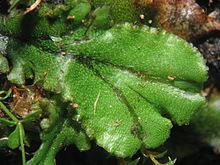Fountain liver moss
| Fountain liver moss | ||||||||||||
|---|---|---|---|---|---|---|---|---|---|---|---|---|

Well liver moss ( Marchantia polymorpha ), spreading over a deciduous moss |
||||||||||||
| Systematics | ||||||||||||
|
||||||||||||
| Scientific name | ||||||||||||
| Marchantia polymorpha | ||||||||||||
| L. |
The fountain liver moss ( Marchantia polymorpha ) is probably the best-known species of Marchantiopsida , it was already described by Linnaeus .
The fountain liver moss was the moss of the year 2013 in Austria and Germany.
description
The thallus of the plant is ribbon-like and up to 2 cm wide and 10 cm long, on the edges with clear notches and a central rib. As with all Marchantiales , the underside of the thallus is provided with so-called ventral scales, with fountain liver moss there are three different shapes: large ones along the midrib, rounded ones on the front edge of the thallus and long, narrow ones on the remaining underside. The shape and combination of the ventral scales are a taxonomic feature for determining the species.
On the thallus, in addition to the pores that can be seen with the naked eye, there are round breeding cups in which small, flattened breeding bodies swim. If these are washed or knocked out of the incubation cup, they germinate in the new location and thus enable the plant to reproduce vegetatively .
The unicellular rhizoids with which the plant anchors itself in the ground can be over 1 cm long, making them the longest cells in the liverwort class.
The fountain liver moss is duplex . The gametangia carriers (gametangiophores) are several centimeters high stalked parts of the thallus. The male gametangia carriers (antheridiophores) are disc-shaped with a slightly lobed edge, while the female (archegoniophores) are star-shaped (like an umbrella frame with 9-11 rays). Spermatozoids released from the antheridiophores are sprayed by raindrops under the umbrella of the archegoniophores. The afterwards from the fused gametes resulting sporophytes consist of tiny capsules which are formed on the underside of Archegoniophoren. Up to 7 million spores are formed per plant .
distribution
The well liver moss is the most widespread and at the same time one of the most common types of liverworts. It occurs worldwide on all continents, from the tropics to arctic regions. Neither certain light nor soil conditions are relevant for it to thrive, only a certain basic moisture is important. The plant is considered insensitive to air pollution and resistant to heavy metals. It not infrequently also settles in locations in urban areas, from flower pots to paving joints.
Systematics
In addition to the type ( Marchantia polymorpha . Subsp polymorpha ) two other subspecies exist:
- Marchantia polymorpha subsp. ruderalis Bischl. & Boiss.-Dub.
- Marchantia polymorpha subsp. montivagans Bischl. & Boiss.-Dub.
use
Because of its similarity to animal livers, fountain liver moss was previously given as a remedy for liver disease and tuberculosis , hence the name of the entire class. As such, it is now out of use. In recent years it has been shown that liverworts have a strong fungicidal effect and can therefore be used successfully to treat skin and nail fungi . It is reported that the effect is many times stronger than that of commercially available fungicides.
Models
literature
- Dietmar Aichele, Heinz-Werner Schwegler: Our moss and fern plants (= cosmos nature guide ). 1st edition. Kosmos - Society of Friends of Nature, Franckh'sche Verlagshandlung, Stuttgart 1956, p. 146-147 et al. ö .
- Roger Phillips: The cosmos book of grasses, ferns, mosses, lichens. A great cosmos nature guide . With the collaboration of Alan Eddy (Moose) a. a. 3. Edition. Kosmos - Society of Friends of Nature, Franckh'sche Verlagshandlung, Stuttgart 1987, ISBN 3-440-05504-3 , p. 156–157 (English: Grasses, Ferns, Mosses & Lichens of Great-Britain and Ireland . London 1980. Translated by Bruno P. Kremer).
- Bruno P. Kremer, Hermann Muhle: lichens, mosses, ferns. European species . Ed .: Gunter Steinbach (= Steinbach's natural guide . Volume 20 ). Mosaik Verlag, Munich 1991, ISBN 3-570-6652-5 ( defective ) , p. 84-85 .
- Jan-Peter Frahm: Biology of Mosses . Spectrum Academic Publishing House, Heidelberg / Berlin 2001, ISBN 3-8274-0164-X , p. 39-41 .
- Michael Sauer: Marchantia L. - Brunnenlebermoos . In: Martin Nebel, Georg Philippi (Hrsg.): Die Moose Baden-Württembergs . tape 3 . Eugen Ulmer, Stuttgart 2005, ISBN 3-8001-3278-8 , pp. 109-112 .
Individual evidence
- ↑ Moss of the year 2013 at the Austrian Nature Conservation Union.
- ↑ An instructive photo shows the different heights of the handles of the gametangia carriers, which facilitate the transport of rain of the spermatozoids from the surface of the male to the underside of the female gametangiophore: Bruno P. Kremer, Hermann Muhle: Flechten, Moose, Farne. European species . Ed .: Gunter Steinbach. Mosaik Verlag, Munich 1991, p. 85 top left .
- ↑ Roger Phillips: The cosmos book of grasses, ferns, mosses, lichens. A great cosmos nature guide . With the collaboration of Alan Eddy (Moose) a. a. 3. Edition. Kosmos - Society of Friends of Nature, Franckh'sche Verlagshandlung, Stuttgart 1987, ISBN 3-440-05504-3 , p. 157 .
- ↑ XZ Wu, AX Cheng, LM Sun, SJ Sun, HX Lou: Plagiochin E, an antifungal bis (bibenzyl), exerts its antifungal activity through mitochondrial dysfunction-induced reactive oxygen species accumulation in Candida albicans. In: Biochim Biophys Acta . 1790 (8), Aug 2009, pp. 770-777. PMID 19446008









